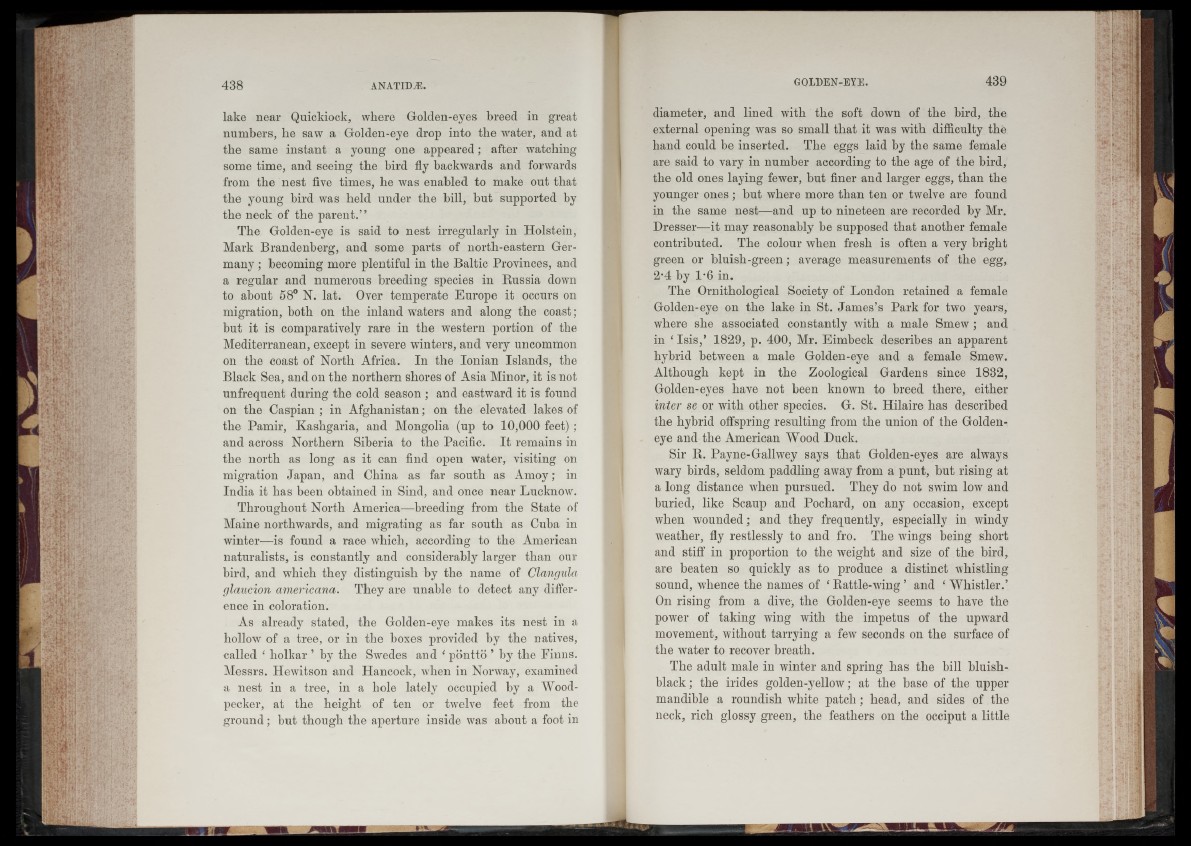
438 ANATIDyE.
lake near Quickiock, where Golden-eyes breed in great
numbers, be saw a Golden-eye drop into the water, and at
the same instant a young one appeared; after watching
some time, and seeing the bird fly backwards and forwards
from the nest five times, be was enabled to make out that
the young bird was held under the bill, but supported by
the neck of the parent.”
The Golden-eye is said to nest irregularly in Holstein,
Mark Brandenberg, and some parts of north-eastern Germany
; becoming more plentiful in the Baltic Provinces, and
a regular and numerous breeding species in Bussia down
to about 58° N. lat. Over temperate Europe it occurs on
migration, both on the inland waters and along the coast;
but it is comparatively rare in the western portion of the
Mediterranean, except in severe winters, and very uncommon
on the coast of North Africa. In the Ionian Islands, the
Black Sea, and on the northern shores of Asia Minor, it is not
unfrequent during the cold season ; and eastward it is found
on the Caspian ; in Afghanistan; on the elevated lakes of
the Pamir, Kashgaria, and Mongolia (up to 10,000 feet);
and across Northern Siberia to the Pacific. It remains in
the north as long as it can find open water, visiting on
migration Japan, and China as far south as Amoy; in
India it has been obtained in Sind, and once near Lucknow.
Throughout North America—breeding from the State of
Maine northwards, and migrating as far south as Cuba in
winter—is found a race which, according to the American
naturalists, is constantly and considerably larger than our
bird, and which they distinguish by the name of Clangula
glaucion americana. They are unable to detect any difference
in coloration.
As already stated, the Golden-eye makes its nest in a
hollow of a tree, or in the boxes provided by the natives,
called £ liolkar ’ by the Swedes and £ pontto ’ by the Finns.
Messrs. Hewitson and Hancock, when in Norway, examined
a nest in a tree, in a hole lately occupied by a Woodpecker,
at the height of ten or twelve feet from the
ground; but though the aperture inside was about a foot in
GOLDEN-EYE. 439
diameter, and lined with the soft down of the bird, the
external opening was so small that it was with difficulty the
hand could be inserted. The eggs laid by the same female
are said to vary in number according to the age of the bird,
the old ones laying fewer, but finer and larger eggs, than the
younger ones; but where more than ten or twelve are found
in the same nest—and up to nineteen are recorded by Mr.
Dresser—it may reasonably be supposed that another female
contributed. The colour when fresh is often a very bright
green or bluish-green; average measurements of the egg,
2-4 by 1*6 in.
The Ornithological Society of London retained a female
Golden-eye on the lake in St. James’s Park for two years,
where she associated constantly with a male Smew ; and
in £ Isis,’ 1829, p. 400, Mr. Eimbeck describes an apparent
hybrid between a male Golden-eye and a female Smew.
Although kept in the Zoological Gardens since 1832,
Golden-eyes have not been known to breed there, either
inter se or with other species. G. St. Hilaire has described
the hybrid offspring resulting from the union of the Goldeneye
and the American Wood Duck.
Sir B. Payne-Gallwey says that Golden-eyes are always
wary birds, seldom paddling away from a punt, but rising at
a long distance when pursued. They do not swim low and
buried, like Scaup and Pochard, on any occasion, except
when wounded; and they frequently, especially in windy
weather, fly restlessly to and fro. The wings being short
and stiff in proportion to the weight and size of the bird,
are beaten so quickly as to produce a distinct whistling
sound, whence the names of £ Battle-wing ’ and £ Whistler.’
On rising from a dive, the Golden-eye seems to have the
power of taking wing with the impetus of the upwrard
movement, without tarrying a few seconds on the surface of
the water to recover breath.
The adult male in winter and spring has the bill bluish-
black ; the irides golden-yellow; at the base of the upper
mandible a roundish white patch; head, and sides of the
neck, rich glossy green, the feathers on the occiput a little